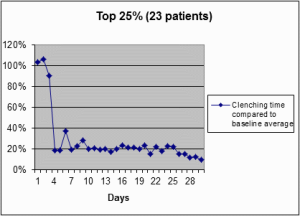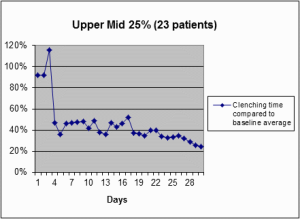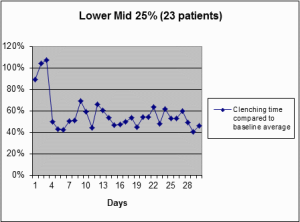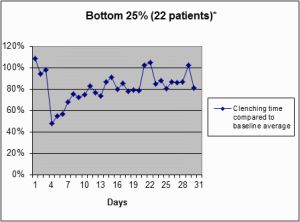 Information for Healthcare Professionals
Information for Healthcare Professionals
Benefits of the SleepGuard biofeedback headband
- Better outcomes with all your TMJ patients
- Increase efficacy of complementary treatments (mouth guards, splints, massage, chiropractic, acupuncture)
- Drastically reduced nighttime clenching
- Quantitative measurement of nighttime clenching (number of clenches, and total damaging clenching time)
- Reduce or eliminate TMJ-related muscle spasms, trigger points, and referred pain
- Reduce or eliminate migraines
- Reduce or eliminate cracked teeth, and need for root canals
- In silent mode, enables quantitative comparison of efficacy of other treatments
- Aid in recapture of displaced articular disc by reducing nightly displacement
- Reduce habitual clenching activity that blocks REM sleep
- Reduce damage to crowns and implants
- Reduce or eliminate ongoing nightly damage to the temporomandibular joint and the articular disc
Below we summarize key information for healthcare professionals regarding nighttime biofeedback and the SleepGuard biofeedback headband, including
- Key differences between nighttime biofeedback and daytime biofeedback (both the method and purpose are quite different)
- Circumstance-caused vs. habitual nighttime clenching
- Characteristics of habitual nighttime clenching
- Therapeutic benefits of nighttime biofeedback for patients who are able to be responsive in sleep, and how these benefits can benefit TMJ treatment outcomes
- Key factors that influence whether a patient will be responsive in sleep
- Benefits by efficacy quartile in a 92-person study
- How nighttime clenching enables migraines in migraine-sensitive brains, and how reducing clenching reduces or eliminates migraines in the majority of migraine sufferers who clench
- Key role healthcare practitioners can play to enable patients to receive the most benefit from nighttime biofeedback
- How to try EMG nighttime biofeedback for free
- Using a single SleepGuard biofeedback headband with multiple patients
- Wholesale purchases and affiliate program
Key differences between nighttime biofeedback and daytime biofeedback
As a healthcare professional, you probably know that EMG biofeedback (usually done in office visits by a biofeedback professional) can help an individual reach a more calm state, with a lower resting level of muscle activity. This reduces the amount of mastication muscle activity that an individual has going on in the background during daily activities. Nighttime EMG biofeedback addresses something quite different.
The purpose of nighttime EMG biofeedback is to modify habitual clenching each time it starts to happen. The SleepGuard biofeedback headband is specifically designed to enable an individual to reduce or eliminate habitual nighttime teeth clenching.
Circumstance-driven nighttime teeth clenching vs. habitual clenching
Some nighttime clenching is circumstance-driven (such as a neurological response to a drug, or the body’s response to a recent or present physical or mental trauma, or a food allergy or sensitivity). However, if nighttime clenching has been present for months or years, it is likely to have become habitual.
Characteristics of habitual nighttime teeth clenching
Can be thought of as an addiction to a sensation that part of the subconscious mind has learned to find soothing (similar to thumb-sucking, nail biting or pencil-biting)
- Continues regardless of whether the original cause is removed
- Clenches typically last 3 to 5 seconds each, with tissue damage accumulating after approximately the first two seconds of each clench
- TMJ disorder sufferers typically have between 20 seconds and 300 seconds of damaging habitual clenching (the part after the first two seconds per clench) each night
Therapeutic benefits of nighttime EMG biofeedback
Tissue damage reduction: reducing nighttime clenching through nighttime biofeedback enables reduction or elimination of nightly ongoing damage to tissue of the articular disc, retrodiscal tissue, cementin tissue, and tooth root tissue.
Myofascial relief
Reducing nighttime clenching directly reduces stress and spasms in the masseter muscles, temporalis muscles, and the medial pterygoid muscles. Reducing nighttime clenching also often indirectly reduces spasms in the lateral pterygoid muscles and many neck and back muscles.
When habitual nighttime clenching is reduced or eliminated, outcomes from many therapies (splint therapy, physical therapy for posture & tongue, trigger point therapy for muscles, chiropractic therapies, etc.) are improved.
Key factors influencing responsiveness to nighttime EMG biofeedback
Depth of sleep
- People who sleep lightly are likely to have their sleep disturbed and thus may not be good candidates for nighttime EMG biofeedback
- Very deep sleepers may require an earphone (available as a custom modification) to provide a louder signal
Level of mental alignment with the process
- Relating to the biofeedback as teamwork and a loving reminder, increases responsiveness and efficacy
- Relating to the biofeedback as aversive therapy, decreases responsiveness and efficacy
- Conditioning: wakeful practice to build an instinctive subconscious response increases responsiveness and efficacy
- Typical efficacy, grouped by efficacy quartiles (25% of patients per quartile)
How nighttime clenching enables migraines in migraine-sensitive brains
In 2007 in an MRI brain scan study at Massachusetts General Hospital, Alex DaSilva, DDS, and Nouchine Hadjikhani, MD compared brain scans of chronic migraine sufferers and a control group, and found that in the region of the somatosensory cortex responsible for processing sensory nerve signals from the face and teeth, chronic migraine sufferers had notably different brain structure.
It appears that in a migraine-sensitive brain, signals streaming into this region of the brain at night from habitual nighttime clenching can set up a trigger condition that allows a migraine to be triggered any time in the following day or so. The clenching usually does not trigger the migraine, but rather enables the migraine wave to propagate through the brain later when a trigger condition (such as a rapid change in photon flux to the eyes) happens.
Reducing or eliminating nighttime clenching allows migraine-sensitive brains to regain more balance and stability during sleep, and thus to be less subject to migraines being triggered.
How to try EMG nighttime biofeedback for free
We are confident that you will find the SleepGuard biofeedback headband beneficial to your practice and to your patients, so we offer to let you try it free. Just call and we will authorize you for a free trial. You may use the SleepGuard biofeedback headband as much as you want during the free trial period at no charge. That’s plenty of time to discover how useful it can be in both quantitative measurement, and treatment.
Key role healthcare practitioners play in enabling patients to benefit from EMG nighttime biofeedback
Individuals who have suffered from TMJ disorder and/or migraines from nighttime clenching for a long time have often become identified with their suffering, and may be jaded about trying new things that might help. Many people have already spent a great deal of money and had their hopes dashed numerous times. Many have come to believe they don’t deserve to get better. Many don’t imagine what life would be like without their pain.
Wholesale purchases and affiliate program
Once you have proven to yourself how valuable the SleepGuard biofeedback headband can be for your practice and for your patients, there are three ways you can make units available to your patients, and two of these ways directly financially benefit your practice.
- Patients may be sent to this website to participate in the free trial or to purchase a unit
- You can become an affiliate and earn a $90 referral fee for each unit sold to a patient you refer
- You can purchase units wholesale and sell them through your practice
Using a single SleepGuard biofeedback headband with multiple patients
If you buy a few extra fabric headbands, it is easy to use the SleepGuard biofeedback headband with multiple patients. It takes less than one minute to swap the electronic module from one fabric headband to another, and alcohol-wipe the module and sensor pads.
Free Support
Becoming an expert at something new always brings a learning curve. We are here to support you at no charge. Please call (781) 643-1242 if you have any questions.




